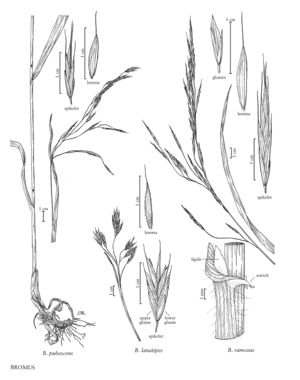Difference between revisions of "Bromus lanatipes"
FNA>Volume Importer |
imported>Volume Importer |
||
| (6 intermediate revisions by 2 users not shown) | |||
| Line 7: | Line 7: | ||
|synonyms={{Treatment/ID/Synonym | |synonyms={{Treatment/ID/Synonym | ||
|name=Bromus anomalus var. lanatipes | |name=Bromus anomalus var. lanatipes | ||
| − | |authority= | + | |authority= |
| + | |rank=variety | ||
}} {{Treatment/ID/Synonym | }} {{Treatment/ID/Synonym | ||
|name=Bromopsis lanatipes | |name=Bromopsis lanatipes | ||
| − | |authority= | + | |authority= |
| + | |rank=species | ||
}} | }} | ||
|hierarchy=Poaceae;Poaceae subfam. Pooideae;Poaceae tribe Bromeae;Bromus;Bromus sect. Bromopsis;Bromus lanatipes | |hierarchy=Poaceae;Poaceae subfam. Pooideae;Poaceae tribe Bromeae;Bromus;Bromus sect. Bromopsis;Bromus lanatipes | ||
| Line 32: | Line 34: | ||
-->{{#Taxon: | -->{{#Taxon: | ||
name=Bromus lanatipes | name=Bromus lanatipes | ||
| − | |||
|authority=(Shear) Rydb. | |authority=(Shear) Rydb. | ||
|rank=species | |rank=species | ||
| Line 39: | Line 40: | ||
|basionyms= | |basionyms= | ||
|family=Poaceae | |family=Poaceae | ||
| + | |illustrator=Cindy Roché | ||
| + | |illustration copyright=Utah State University | ||
|distribution=Okla.;Ariz.;Colo.;N.Mex.;Tex. | |distribution=Okla.;Ariz.;Colo.;N.Mex.;Tex. | ||
|reference=None | |reference=None | ||
| Line 44: | Line 47: | ||
|publication year= | |publication year= | ||
|special status= | |special status= | ||
| − | |source xml=https:// | + | |source xml=https://bitbucket.org/aafc-mbb/fna-data-curation/src/200273ad09963decb8fc72550212de541d86569d/coarse_grained_fna_xml/V24/V24_309.xml |
|subfamily=Poaceae subfam. Pooideae | |subfamily=Poaceae subfam. Pooideae | ||
|tribe=Poaceae tribe Bromeae | |tribe=Poaceae tribe Bromeae | ||
Latest revision as of 17:22, 11 May 2021
Plants perennial; not rhizomatous. Culms 40-90 cm, erect; nodes 3-5(7), mainly pubescent; internodes mostly glabrous, puberulent near the nodes. Basal sheaths densely pilose or glabrous; upper sheaths glabrous or almost so, midrib of the culm leaves not abruptly narrowed just below the collar; auricles absent; ligules 1-2 mm, glabrous, truncate or obtuse, sometimes lacerate; blades 5-20 cm long, to 7 mm wide, flat, both surfaces glabrous, sometimes scabrous. Panicles 10-25 cm, open, nodding; branches ascending to spreading. Spikelets 10-30 mm, elliptic to lanceolate, terete to moderately laterally compressed, with 7-12(16) florets. Glumes usually glabrous, sometimes pubescent; lower glumes 5-6.5(7) mm, 1(3)-veined; upper glumes (6)7-9 mm, 3-veined, not mucronate; lemmas 8-11 mm, elliptic, rounded over the midvein, backs and margins pubescent, sometimes nearly glabrous, apices truncate or obtuse, entire, rarely emarginate, lobes shorter than 1 mm; awns 2-4 mm, straight, arising less than 1.5 mm below the lemma apices; anthers 1.8-4 mm. 2n = 28.
Distribution
Okla., Ariz., Colo., N.Mex., Tex.
Discussion
Bromus lanatipes grows in a wide range of habitats at 800-2500 m, from Wyoming through the southwestern United States to northern Mexico.
Selected References
None.
